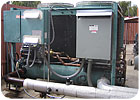
The center had a new 88-ton air-cooled chiller with two reciprocating compressors installed as part of a 1996 upgrade, but that retrofit didn't go as smoothly as planned. Numerous problems kept occurring over the years, including continually failing compressors, excessive noise, and significant amounts of oil in the refrigerant.
In April 2005, one of the reciprocating compressors failed again, and the replacement cost was estimated to be $12,800. Instead of once again replacing the failed component with another reciprocating compressor, the chiller was retrofitted with one R-134a, 80-ton, oilless, centrifugal Turbocor compressor. Ever since the changes were made, the chiller has been running smoothly

TIME FOR SOMETHING NEW
One of the reasons why there were so many problems with the chiller was the fact that it had no controls, said Ben Erpelding, PE, CEM, engineering manager, San Diego Regional Energy Office (SDREO). "The compressors would short-cycle and experience high condensing temperatures. When one of the compressors failed again last year, we needed to get cooling quickly. If we'd had the money, it would've been ideal to replace the whole chiller. That wasn't an option, though, so we went with the Turbocor retrofit."
Fortunately, Erpelding's department had already been researching the Turbocor compressor, so they had data to convince the county of San Diego that this new component would solve their problems. They explained that Danfoss' Turbocor compressor is completely oil-free and its magnetic bearings provide essentially frictionless operation, which reduces noise and vibration. The compressor weighs 80 percent less than a traditional compressor, and it also has an integrated variable frequency drive (VFD) that provides better part-load efficiency, according to the company.
Shaw, who has been retrofitting chillers with Turbocor compressors for about three years, noted that the long operational hours and part-load conditions at the center made the facility a perfect candidate for a Turbocor retrofit. Indeed, with the temperate climate in San Diego, chillers run at part load for all but 1 percent of the year.
"The BAS now controls everything in the building from lighting to cooling, which really helps with the energy savings," said Erpelding. "Another benefit is when an employee complains of being too hot or too cold, the maintenance guys can make changes to the system right from their desks without having to run over there."

LESS NOISE, MORE SAVINGS
The center is located in a residential neighborhood, and the old compressors were very loud. Previously when the system cycled on, several commented that the compressors sounded like they were screaming. With the new Turbocor compressor, noise is a thing of the past. "Now the condenser fans are louder than the compressor," said Erpelding.
In addition, the retrofit is saving the center money on energy costs, and the county of San Diego is on track to recoup the $22,485 cost of the compressor upgrade within three years (See Figure 1). According to multiple spot measurements taken before the retrofit, the existing chiller with the reciprocating compressors consumed 1.4 kW/ton. Based on 15-minute interval data collected between January and October 2006, the variable-speed chiller with the new Turbocor compressor consumes an average of 0.86 kW/ton.

The entire retrofit went very smoothly, said Erpelding. In fact, maybe it went a little too well. "The chiller worked really great right away. After everything was done, instead of people complaining it was hot, they were actually complaining it was too cold. That was an easy one to fix," he said. And since then, the chiller has run nonstop (except for a transformer failure this summer) - even through 110-plus degree days - allowing the center to serve the needs of the community virtually without interruption.
Publication date: 11/13/2006


Report Abusive Comment